(Week 42, 2002, 14 Oct - 20 Oct.)
In the display above (click to enlarge), the solar X-ray fluence seen by RESIK (black points) is plotted atop GOES red line. Only periods with good spectral measurements are indicated. The total number of good spectral measurements is given in the title line.
Missing data due to telemetry
gaps:
total ~2 h
The launch of CORONAS-F
The CORONAS-F launch took place early morning on 31 July 2001 from Plesetsk Cosmodrome. Below is a schematic map of the Plesetsk range (more info available on (http://www.russianspaceweb.com/plesetsk.html)
Documentary photos of the launch
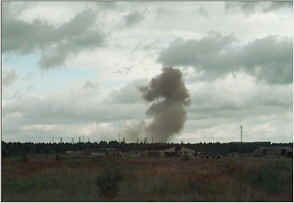 |
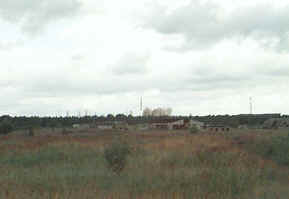 |
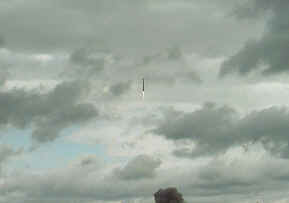 |
The satellite launch was perfect, and CORONAS-F has been put into the
polar orbit characterized by
Period: ~ 95 min
Perigee: ~501 km
Apogee: ~548 km
Inclination: ~82.5 deg.
Such an orbit ensures repeated (~20 day) periods of continuous illumination of the S/C
i.e. long CORONAS-F "days"
22 Aug - 7 Sep. 2002
13 Feb - 8 Mar. 2002
18 May - 5 Jun. 2002
20 Aug - 1 Sep. 2002
next: 8 Feb - 1 Mar. 2003
Coronas-F rocket
The booster used was Tsyklon-3 rocket made by Yuzhnoe in Dnepropetrovsk, Ukraine. (For details of the family of Tsyklon boosters see: (http://www.russianspaceweb.com/tsyklon.html). Below are some photos of the rocket, which we found on the Internet.
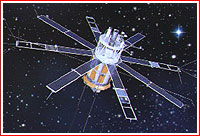 |
The scientific payload called AUOS (http://www.russianspaceweb.com/auos.html) involves several instruments described in more details on the CORONAS-F Project web site
(http://coronas.izmiran.rssi.ru/).
Satellite artist impression is shown to the left. |
Placement of our instruments within the payload – assembly phase in Plesetsk
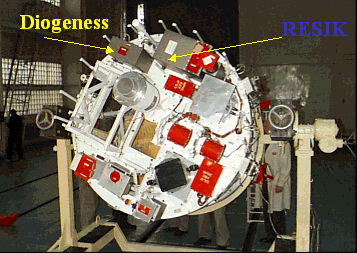 |
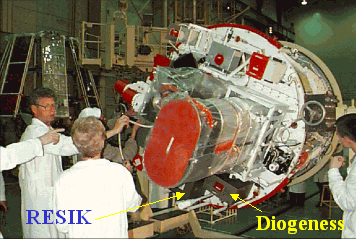 |
Below is a kind of "official info" released after the launch - sorry for the language.
Polish X-ray Package aboard CORONAS-F orbiting observatory
After a longer period of relative inactivity, the programme of space astrophysical exploration has been resumed in Russia on July 31, 2001, by launching the CORONAS-F Solar Observatory from Plesetsk Cosmodrome into the polar orbit. Among a dozen of instruments aboard this medium size satellite (~2400 kg) were two Polish instruments – Bragg crystal spectrometers: RESIK and Diogeness developed at the Wroclaw Solar Physics Division of Polish Academy of Sciences Space Research Centre. The principal investigator for both instruments is doc. dr hab. Janusz Sylwester, but the polish instruments launched have been developed under a wide international co-operation. In case of Diogeness flat crystal spectrometer, Ondrejov, Czech Academy of Sciences Astronomical Institute has been involved. The Consortium involving the two British Institutes has developed RESIK – bent crystal spectrometer: the Mullard Space Science Laboratory and the Rutherford Appleton Laboratory, the Naval Research Laboratory from USA and the Russian Institute IZMIRAN is leading the entire Mission under guidance of Professor V.N. Oraevsky
In both spectrometers, the ideal crystal lattices of selected monocrystals are used as dispersion elements for the X-ray radiation produced in solar flares – the hottest and the most energetic phenomena in the Solar System. The physics of energy release in flares is not yet known as concerns the basic processes leading to transformation of energy stored in powerful magnetic fields of sunspots into the kinetic energy of particles accelerated up to GeV energy range and heated to tens of million Kelvin. Several important projects have been launched over previous years in order to unveil the physics of huge energy release in flares (in 1980, the NASA’s Solar Maximum Mission, in 1991, the Japanese Yohkoh Observatory, in 1996 the ESA’s SOHO Mission and recently in 2002, the HESSI High Energy Observatory).
CORONAS-F with its unique scientific payload complements the SOHO and HESSI covering the intermediate energy range by its observations. The Polish spectrometers have been designed in order to investigate the soft X-ray spectra of flares in the energy range between 2 and 10 keV, where many strong emission lines are present forming in the highly ionised plasma. The strongest lines belong to hydrogen and helium- like ions of aluminium, silicon, sulphur, argon and potassium.. It is known from about 20 years, that the chemical composition of this hot flaring plasma do vary between events depending on the first ionisation potential (FIP) of the particular element. Unexpected discovery of variations of flare plasma composition has been made by Wroclaw team and published in Nature in 1984 and RESIK and Diogeness instruments have been designed in order to determine the composition of hot coronal plasma with the unprecedented accuracy. In Diogeness, in order to resolve the X-ray spectra, the four dispersive elements i.e. flat monocrystals of Quartz (two), silicon and ADP are mounted on the moving shaft and rotated relative to the direction to the Sun. Spectra are measured by four gas-filled proportional detectors. Two Quartz crystals are for the first time mounted in so-called Dopplerometer configuration allowing for precise determination of the motions of emitting plasma along the line of sight. In addition, the broadband detectors in two energy regions monitor the time variations of solar X-ray flux: 2 – 4 keV and 4 – 8 keV with high time resolution (2 sec.). In RESIK, instead of rotating the crystal, its surface is bent in order to resolve the spectrum that is recorded using unique position sensitive proportional counter. The size of Quartz and silicon monocrystals (130mm x 40mm) used is unprecedented and allows to observe not only the flare spectra, but also spectra of solar corona in periods of lower solar activity. Studies of K/Ar abundance ratio variations for flares may shed more light on the problem of basic mechanisms of energy release in flares. Understanding of basic energy release processes is of primary importance for astrophysics, as flares are observed on most of stars and the other objects. Observing solar flares gives the best chances to see details of the process because of solar proximity. This proximity put us, observers, in some danger however, as solar flares, especially these most energetic, strongly influence space weather. Large flares caused power-outs in energetic grids (Quebec, in 1989) and lost of few satellites in orbit. They present substantial radiation exposure threat to the astronauts/cosmonauts inhabiting the International Space Station. Analysis of Diogeness and RESIK data may help to better predict the occurrence of such large events. We are changing the operation modes of the instruments as solar activity dictates, by reprogramming onboard instrument computers remotely from the ground using dedicated IZMIRAN ground station near Moscow. Data from described Polish spectrometers are unique and of primary importance for solar physics and are available to the community. The amount of data already collected is ~2 GB and increases at the rate of 50 MB/day. The life of CORONAS-F satellite is expected to be as long as the system will work covering thus the decaying portion of 23rd cycle of solar activity.
Report prepared by: Janusz Sylwester js@cbk.pan.wroc.pl
The report presented has been done in "real time" and so it may
contain jargon, blunders, or trivialities. We do not have also an English native
speaker in our Wroclaw group! We would be happy to discuss problems mentioned
above in more details if necessary.
RESIK data are in the open public domain and can be requested from: http://surfwww.mssl.ucl.ac.uk/surf/data_request.html.
Page made on 23 October 2002 by: Jarek Bakala jb@cbk.pan.wroc.pl